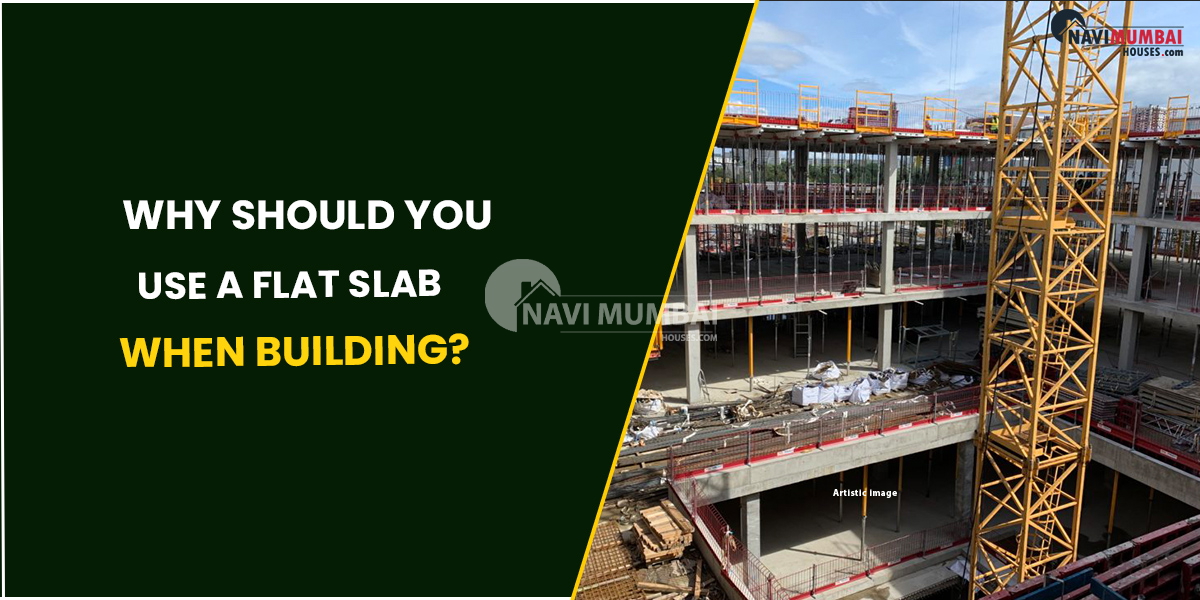
- November 16, 2022
- News
Why Should You Use A Flat Slab When Building?
Flat Slab When Building : A flat slab is a reinforced concrete slab that is supported by columns.
Columns and beams support the slab in a traditional building. By directly supporting the slab with columns, the flat slab method eliminates the need for beams. A flat slab is a popular choice for constructing asymmetrical column layouts due to its practicality, versatility in interior design, and ease of construction. This article will provide you with all of the information you need to make an informed decision.
Are you looking flat for sale in kharghar?
What is a flat slab?
A flat slab is a reinforced concrete slab that is supported by columns. A flat slab behaves similarly to a two-way slab, with its thickness generally being greater than the thickness of the concrete surface in a beam-slab system. IS 456:2000 requires flat slabs to be at least 125 millimetres thick.
Where is a flat slab used?
Most buildings use flat slabs, especially in areas that require greater aesthetics and light dispersal or where the construction requires less formwork. Flat slabs are commonly used when constructing uneven column layouts, such as ramps, storeys with bent shapes, and so on, in public spaces such as theatres, skyscrapers, parking garages, and so on.
Using flat slabs creates favourable conditions for building flat soffits, provides a depth solution, and allows for greater design flexibility. Flat slabs provide a great deal of pliability and can be used wherever internal layouts may need to be changed in the future.
Types of flat slab
A straightforward flat slab
A simple flat slab is often made of concrete and is supported by caps and columns rather than beams. The simple flat slab can be built with little effort and with only a small amount of formwork.
As a result, the loads of the building are transmitted into the columns, allowing the structure to maintain an efficient balance. These simple flat slabs are suitable for spans of 6 to 9 metres in length.
The term “span” in this context refers to the distance between the structure’s two discrete supports. Similarly, flat slabs are the best choice for dynamic loads weighing 7 kN/m2 and higher.
Drop panels on a flat slab
Slabs with drop panels and column capitals are referred to as “flat slabs with drop panels.” The drop panel refers to the increased thickness of the slab at its uppermost column. These drop panels significantly improve the shear resistance of the flat slab.
The addition of drop panels to the flat slab increases the structure’s ability to absorb negative moments. The negative moment capacity is the bending moment produced when the compressive stress from the bottom end of the beam interacts with the tensile stress from the top side. These flat slabs significantly reduce deflection while increasing overall stiffness.
Column heads on a flat slab
A column head is a reinforced concrete expansion that is placed on top of a column and serves as an essential component of the system. The angle of such column heads could be designed to be whatever the architect desired for architectural applications. If designs are to be stamped into the concrete, the concrete should be placed at a 45-degree angle on both sides of the column.
Failures in the flat slab
Punching shear failure is a major concern when designing flat slabs. Extreme localised stress causes the flat slab to fail. This usually happens near the base of the column or where the column meets the slab.
When the focused support reaction of a column exerts a pushing force on the slabs, the loads cause fractures to form all over the loaded sections of the slab, resulting in a truncated failure of the slab. To address this issue, the following approaches are being taken:
- Increase the overall thickness of the slab, including column heads and drop panels.
- By increasing column size, the shear perimeter can be hidden.
- Provide the necessary shear reinforcement.
Flat slab: The benefits and drawbacks of a flat slab
Advantages
Flat slabs have several advantages over traditional slabs, which will be discussed further below.
Rapid development
Because there is less need for formwork when constructing flat slabs, the construction time is reduced. Furthermore, the use of tabular formwork could simplify and reduce the amount of labour required to complete the project. Precast welded mesh reduces the time it takes to set up flat slabs, allowing more time to place vertical members and thus speeding up the construction process.
Designer adaptability
Designers can express themselves more freely when working with flat slabs because walls do not limit them. The overall floor plan can be changed without affecting the structure of the building. Furthermore, higher-quality management is more widely available and is thought to be superior in terms of fire resistance. Reinforcement details for a flat slab become less complicated, and design work for a specific soffit level is possible.
The proprietor’s ability to be flexible
Because a flat slab allows for a great deal of interior plan flexibility, it can be easily modified if revisions are required or if the occupier desires room for future growth. As a result, designers and owners benefit from the adaptability provided by a grid that excludes beams that are perpendicular to square or near-square intersections.
A lower storey height
The combined thickness of the beam and the slab in the beam-slab system is greater than the thickness of the flat slab. When the length of the storey’s vertical elements is reduced, the total height of the building is reduced, and as a result, the building’s own weight is reduced. This technique is most beneficial to high-rise buildings because the total saved height and reduced self-weight can significantly reduce development costs.
Installation of electrical and mechanical systems is simple.
There are no beams in buildings with flat slabs. As a result, no cables must be bent or beams must be cut to provide mechanical and electrical services. Flat slabs make it easier to install items such as air conditioning ducts, fire suppression ducts, and electric ducts.
Aesthetics, acoustics, and light dispersion
A flat slab can provide an intriguing glimpse of the structure’s interior. The entire slab is completely clear and open for any and all uses because there are no beams or dividing walls to get in the way. Light is more diffused in all directions, and the lack of decoration on the ceiling helps to keep the room evenly lit. Most auditoriums are built with flat slabs to allow light and sound to spread as far as possible.
Disadvantages
Before deciding to use a flat slab for your building project, you should consider not only the benefits but also the drawbacks of doing so.
Thickness
The thickness of the flat slab is significantly greater than that of the slab used in the beam-slab system. As a result, a significant amount of concrete is used in the construction process.
Flat Slab When Building: Limitations on span
A larger span corresponds to a higher bending moment value. To meet this challenge, effective slab depth will need to be increase, and drop panels and columns may need to be larger in diameter.
Flat Slab When Building: Prone to lateral loading
Brittle (masonry) partitions are not a good choice for being supported by a flat slab structure when it comes to resisting lateral stresses caused by wind, earthquakes, and other seismic activity.
Flat Slab When Building : Obstacles and failure
Drop panels should be limited in their ability to interfere with mechanical ducting. Vertical penetrations, also known as punching shear failure, must be avoided in areas around columns.
You’re looking for Buy Home In Mumbai we have the Best Buy Properties In Mumbai Like Ready to Move & Nearby possession: https://navimumbaihouses.com/property/search/buy/mumbai-all/
If you want daily property update details please follow us on Facebook Page / YouTube Channel / Twitter


